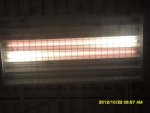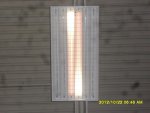Some types of lamp contain contain mercury amalgam rather than pure mercury.
These lamps do not operate properly at much reduced power as on battery emergency lighting ballasts, or on line voltage dimming ballasts.
These lamps have to run fairly warm to light correctly and most battery ballasts dont put enough heat into the lamp.
It is best to use non amalgam lamps in such fixtures.
Another less likely possibility is that the lamps are very near end of life. Sometimes nearly dead lamps still work at full power on line voltage but not at much reduced power on batteries.
The reason being that the mecury dose in the lamp is largely used up* For the lamp to work correctly it is not the actual weight of mercury that is important, but the partial pressure of mercury vapour. Even a less than proper amount of mercury in a hot lamp will work ok, but not in a lamp that is cold due to low power operation.
*the mercury is not actually consumed, but it tends in time to form compounds with the other materials in the tube and therefore not be available for correct operation.
Due to the toxicity of mercury, manufacturrers are reducing the dose per lamp, sometimes they overdo this and otherwise servicable lamps fail due to mercury depletion.


